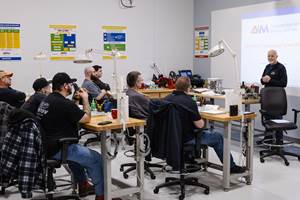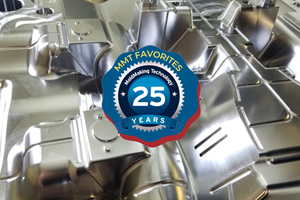Five Rules to Problem Solving in Your Shop
The best time to train your shop personnel is when an error is first detected; it also is the best time to solve a problem.
Lean manufacturing affords the moldmaker two great opportunities: (1) to make molds that will enhance world-class manufacturing for their customers, and (2) to find ways to create a lean environment within their own shops.
Taiichi Ohno, vice president of production at Toyota and Dr. Shigeo Shingo, author and consultant to Toyota, co-creators of The Toyota Production System (just in time or lean manufacturing) discovered that the fastest way to success was not making machines faster, but stopping, shifting, and focusing on the total elimination of non-value added wastes: overproduction, processing, defects, waiting, transportation, inventory, motion and not using the creative talents of each worker.
The lean revolution started when Ohno came over to Dr. Shingo and said, "We must reduce the changeover time on this punch press from four hours to two." Dr. Shingo said, "Okay." A few days later, Ohno came by again and said, "Two hours is not good enough; we must do the changeover in less than 10 minutes." And Dr. Shingo said, "Okay." And with that he found a new methodology to reduce virtually all changeovers to less than 10 minutes. This series on lean manufacturing will explain how the moldmaker can play a vital role in the current lean revolution.
The power of lean manufacturing resides in the philosophy that all employees should be involved in solving problems. Toyota recognizing this philosophy developed a system called Jidoka, which gives all workers the power to stop the line and all other employees from working until the problem is resolved.
A moldmaker runs into many problems during the day; however, these problems are often overlooked. Following are details to implementing Dr. Ryuji Fukuda's—VP production at Sumitomo Electric—powerful method of ensuring that all defects and problems are quickly resolved.
Dr. Fukuda says, "The best time to train workers is when an error is first detected. It also is the best time to solve a problem." Following are the five rules to making on-error-training (OET) work.
On-Error-Training
- Himself/Herself Rule
The worker who first detects the problem becomes primarily responsible for finding the root cause of the problem, so that the defect will not occur again. For example, a worker forming a new mold notices a slight defect. The worker would immediately alert their fellow workers of a pending problem by pulling a cord or pressing a button to stop production. - Quickly Rule
The problem must be dealt with immediately. The best time to solve a problem is when the information is right at hand. The worker would stop working and call over his/her team to help determine the cause of the problem. - Actually Rule
The person plays back the process that transpired before the defect occurred and the defect is re-created—if possible, in front of the group. This rule gives the worker who first who detected the problem the opportunity to grow on the job. Instead of the supervisor coming up with all of the answers, the worker is challenged and empowered to take a prime role in problem-solving activities. - Support Rule
The person who detected the problem becomes the person primarily responsible for solving it, but they do call over their supervisor and fellow workers—everyone stops working and extends his/her support to the process of problem solving. Just look at the power and respect given to the worker. If you want zero defects this is one way to get it. - Don't Speak Rule
The discoverer of the problem is the person expected to solve it. He or she must be allowed the time to discuss the problem and attempt to solve it. Other workers can help, but the supervisor or manager must keep quiet to give the workers a chance to solve the problem on their own. If the workers cannot solve the problem, then the supervisors can offer their suggestions. The effect of sending a mold to a customer with a defect can be devastating. I once stopped an inspector at General Motors who was checking out an automobile door panel. I asked him, "How many doors do you think have been stamped out prior to you inspecting this one?" He answered, "Maybe a thousand or two." "What if this door is not correct? How would you handle this and all the others?" He smiled and said, "We have very good rubber mallets to make the doors fit." I think the age of good rubber mallets is on the way out. We have to ensure that the molds are perfect before they leave the shop.
The simplicity and brilliance of this process is amazing. Dr. Fukuda taught that OET in the first year reduces the rejection rate by more than 90 percent. If we really want to empower employees and let them grow then we should implement OET. We must invest in this methodology to allow people to stop the process for a short period of time to detect and eliminate the causes of defects. In the long run we will be much further ahead.
Mr. Ohno and Dr. Shingo started the lean process by looking at changeovers on punch presses. They knew that Henry Ford in 1926 was able to produce an automobile in only four days while it was taking Toyota and General Motors eight to 10 weeks. After applying lean principles, Toyota can now make an automobile in two days. Kodak studying Toyota's lean principles recently eliminated $450,000,000 in inventory—freeing up vital cash to allow Kodak to reorganize.
Think about the non-value added wastes that may be present within your mold shop (overproduction, processing, defects, waiting, transportation, inventory, motion and not using the creative talents of each worker) and the way it manufactures molds. The next article will begin to look at the fundamental principles of lean manufacturing and how you can apply them in your shop, and will also include a review of the methodology used to reduce setup times on changeovers from hours to minutes.
Some Lean Background
It was the day after my birthday in August 1979 when I read the financial page of the New York Times and saw that productivity had declined in the U.S. for the first time in 33 quarters. The very next day after reading the article, I went to the Greenwich, CT Library and at first found very little information on productivity. However, I was undaunted and proceeded to study nightly on the subject. I found that Japan was the productivity growth leader in the world but I couldn't find out why.
At first, I thought the Japanese were successful since they were smaller size people; that their factories were smaller and easier to work in. I also thought that Japanese were by culture more group and team oriented. Eventually I found information on quality control circles and was sure that was the secret of Japan's success.
I decided to publish a newsletter called Productivity and produced the first issue in June of 1980. Then in February 1981 I enticed 19 senior executives to go with me to Japan to discover what the Japanese were doing that we were not. I didn't speak a word of Japanese; I didn't know a soul in Japan; and I had no contacts there.
But, we did learn that Japan's success came from three basic concepts: (1) continuous improvement by involving all employees in creative problem solving activities, (2) a strong focus on improving the quality of their products; and, (3) a new way of manufacturing—The Toyota Production System.
Most of what I learned I truly did not absorb until many years later. I learned many of the fundamentals of the Toyota Production System, but I did not fully understand nor appreciate the real power of it. However, I was most impressed on this first visit meeting Dr. Ryuji Fukuda—winner of the Nikkei QC Literature Prize awarded by The Deming Prize Committee—and being introduced to his on-error-training.
Related Content
Tackling a Mold Designer Shortage
Survey findings reveal a shortage of skilled mold designers and engineers in the moldmaking community, calling for intervention through educational programs and exploration of training alternatives while seeking input from those who have addressed the issue successfully.
Read MoreMold Maintenance Continues to Matter: Enhanced Training Program in a New Facility
I attended a MoldTrax mold maintenance workshop in 2019 and shared my experiences, and despite changes in ownership, the workshop's remarkable value endures, as discussed in a recent Q&A with the current leadership.
Read MoreThe Role of Social Media in Manufacturing
Charles Daniels CFO of Wepco Plastics shares insights on the role of social media in manufacturing, how to improve the “business” side of a small mold shop and continually developing culture.
Read MoreLeading Mold Manufacturers Share Best Practices for Improving Efficiency
Precise Tooling Solutions, X-Cell Tool and Mold, M&M Tool and Mold, Ameritech Die & Mold, and Cavalier Tool & Manufacturing, sit down for a fast-paced Q&A focused on strategies for improving efficiencies across their operations.
Read MoreRead Next
The Lean Question: How Soon Can I Get Started?
Too many moldmakers are still asking,“Is this for me?” when they should be asking, “How soon can I get started?”
Read MoreHow to Use Continuing Education to Remain Competitive in Moldmaking
Continued training helps moldmakers make tooling decisions and properly use the latest cutting tool to efficiently machine high-quality molds.
Read MoreAre You a Moldmaker Considering 3D Printing? Consider the 3D Printing Workshop at NPE2024
Presentations will cover 3D printing for mold tooling, material innovation, product development, bridge production and full-scale, high-volume additive manufacturing.
Read More




















